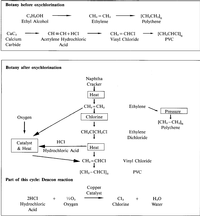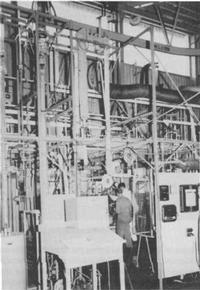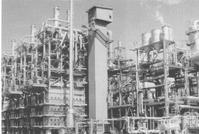


Chapter 9
I Introduction
II The Australian Chemical Industry
III Pharmaceuticals
IV Chemists In Other Industries
V The Dawn Of Modern Chemical Industry - High Pressure Synthesis
VI The Growth Of Synthetic Chemicals - Concentration, Rationalisation And International Links
VII Australian Industrial Chemical Research Laboratories
VIII The Plastics Industry
i Plastics processing
ii Phenol - basis of the first plastic
iii Plastics - the first generation
iv Plastics - the second generation - from petrochemicals
v Styrene monomer - the West Footscray petrochemical complex
vi The Botany petrochemical complex
vii The petrochemical complex at Altona
viii CSR - from sugar alcohol to petrochemical OXO alcohol
IX The Paint Industry
X Acknowledgements
References
Index
Search
Help
Contact us

international success and an Australian plant (continued)
The ICI Australia team well understood the importance of its patent position. In the case of a major discovery, such as a new oxychlorination route, the Australian position differed from that of major countries, say the USA. There the main source of revenue was the domestic market. In Australia it was small and less profitable, whereas world-wide royalties could far exceed domestic income. A thorough patent study however, proved a disappointment. In the 1930s I. G. Farben's indefatigable chemists had thoroughly explored the chemistry of ethylene -then little more than a laboratory curiosity -and surrounded it with patents, one of which disclosed the ICI Australia route. The team had merely made a re-discovery, albeit with more propitious timing. The early disclosure forced ICI Australia to confine its patenting to[121] much narrower aspects of the catalyst, which left the path open to alternatives. Indeed, both in the USA and UK, competitive teams were already working on the same route.

While ICI Australia's team was large enough to work out the laboratory chemistry in full, rumours of competitive developments in the USA made it imperative to accelerate the project. This, again, was a dilemma typical of chemical industrial research in Australia -should one try to tackle the project in its entirety with a relatively small team, at the cost of serious delay, or seek support? ICI Australia sought support from the Parent Company, one of the largest PVC producers in the world, and an American company experienced in chemical engineering aspects of the process. ICI Australia, however, retained the lead role. A pilot plant was built in Australia (Fig. 28), and in 1963, ICI Australia's Board took the decision to proceed with a full scale plant. Management was aware of the risks; starting up an entirely new process is never the same as technology transfer from established plants. There were months of agony before the plant reached performance specifications, and management paid for the courage of its conviction. Yet all was well in the end. In 1967, ICI Australia launched the first oxychlorination plant (Fig. 29) in the ICI family and led this development world-wide. Most important, however, for the company was that it made possible its main objective -to develop a group of processes around an (almost) world-scale naphtha cracker, (by 1960 standards) large enough for a modern petrochemical complex.


Organisations in Australian Science at Work - Botany Petrochemical Complex; I.C.I. Australia Ltd; I.C.I. Australia Ltd. Central Research Laboratories
 |
Australian Academy of Technological Sciences and Engineering |  |
© 1988 Print Edition pages 703 - 704, Online Edition 2000
Published by Australian Science and Technology Heritage Centre, using the Web Academic Resource Publisher
http://www.austehc.unimelb.edu.au/tia/671.html